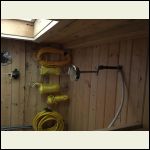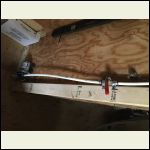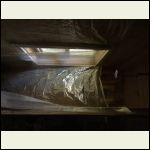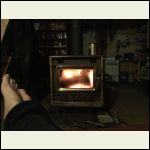| . 1 . 2 . >> |
| Author |
Message |
keystone
Member
|
# Posted: 18 Jun 2020 01:23pm - Edited by: keystone
Reply
Hi everyone, longtime lurker but decided to post now for some ideas/suggestions.
I have a cabin in the Wyoming mountains, 9000 feet elevation. For water we currently use an old cistern that is probably 80 gallons or so, is located about 600 feet up the hill from our cabin and water is gravity fed down a long 1" PVC pipe to the cabin. There is plenty of water and pressure. I use an eccotemp L10 for a kitchen sink, bathroom sink, and shower. The problem I have is that the water heater is outdoors of course, the pipe down the hill from the cistern is just sitting on the ground, and most of the cabin piping is in the uninsulated cabin crawl space, and the cabin itself is 1950s era construction, not that well insulated. This all means the water is only really useable about 3-4 months out of the year when its safe from freezing. I'd like to have water at least 3 seasons if not 4 as I enjoy snowmobiling to it as well. Does anyone have something similar and how have you been able to overcome this?
I was thinking of perhaps burying a water tank behind the cabin with it being fed from the pipe that already comes down the hill, putting a pump in it, and then burying the pipe to the cabin, then putting as much insulation on the pipes in the crawl space as humanly possible, maybe with some kind of solution to easily empty the pipes when you leave in the winter and I would need some kind of indoor water heater? There is electricity but the cabin does not stay heated in anyway when not occupied. I'd just really like to be able to enjoy a warm shower/do some dishes after a day of snowmobiling.
Or is there some kind of simpler solution I am missing? The cabin isn’t going to be lived in for any extended time in the winter so it doesn’t have to be super complex, so some kind of small portable indoor water heater that I haven’t seen that doesn’t require a massive plumbing overhaul?
|
|
ICC
Member
|
# Posted: 18 Jun 2020 04:22pm - Edited by: ICC
Reply
get a cistern that is designed to be buried. Spherical are best as they can be emptied whereas rectangular or loaf shapes need to always be at least 25% full. I guess that only matters if you forget and empty it.
It would either need to be buried as deep as the local frost depth or have a layer of insulation above the tank with something like 2 or 3 feet of dirt on top.
Use a submersible pump like a bilge pump in the cistern to pump water up into the cabin to a smaller fresh water tank like in an RV. The pump must not have a back flow preventer foot valve because you want the water in the tubing that connects the cistern pump to the cabin tank to be able to flow back into the cistern to prevent it from being frozen.
Use an RV water pump in the cabin to distribute the water from the inside storage tank.
If you choose an on demand water heater make sure it is easy to drain to prevent freeze damage. Consider a small tank type RV propane water heater. Easy enough to drain those.
Optimistic mentioned he has a setup like this in a current topic. Maybe he has pictures?
https://www.small-cabin.com/forum/3_9801_0.html
|
|
keystone
Member
|
# Posted: 19 Jun 2020 10:06am
Reply
Thanks I will write him and thanks for your ideas. I always forget to think about the RV market since there are similar needs. Is there such a thing as a 5 or 10 gallon electric water tank with heater/integrated pump/shower system? Something you could heat up and just put in the shower in the winter and use stand alone? Has anyone seen such a thing? I see the propane ones but not sure about using that indoors?
|
|
jsahara24
Member
|
# Posted: 19 Jun 2020 01:36pm
Reply
I've seen some folks heat their water up on a wood stove or similar, then use a RV pump to pump it to a handheld shower head on a flexible line. Might be a simple option for you.
|
|
Brettny
Member
|
# Posted: 20 Jun 2020 08:30am
Reply
I looked for an underground potable water tank..those round tanks are very expensive. I settled on a in truck tank that I wont burry more than 12in underground, frost is 4ft here.
If you have electric I suggest useing heat tape then wrapping with insulation. I would still drain the system when your gone for more than a few days.
|
|
ICC
Member
|
# Posted: 20 Jun 2020 10:50am - Edited by: ICC
Reply
Quoting: Brettny .those round tanks are very expensive.
But they work.
If you bury a tank 1 foot in a 4 foot frost area at some point the water will freeze. You may be able to use rigid xps sheets to make an upside down box enclosure over it, open end down. That can help keep the earths heat in to stop freezing.
I have concrete cisterns buried for rainwater storage over winter.
|
|
Brettny
Member
|
# Posted: 20 Jun 2020 11:54am
Reply
Yes they do work. I was looking really for a fall time water tank, mostly just to not freeze durring hunting season. I do plan on foam board above it as well as provisions to drain the tank.
I paid $120 for this 210gal second hand pickup truck tank. Looking at IBc totes and other cheap tanks they are very hard to burry and not have collapse. This is going under the south side of our cabin. If I had to rent a machine, hand dig or pay someone to put this tank in I would be useing a sphear tank.
Also our tank will be filled via a tank up on the hill just like yours. My water line is above ground because so is the top tank. This makes it very easy to drain the system. Just pickup the pipe and start walking down hill. I'm going to use a float valve in the bottom tank feed from the top tank to keep it full.
https://www.amazon.com/QWORK-Adjustable-Hydraulics-Pneumatics-Plumbingall/dp/B081VBQZ XS/ref=sr_1_16?dchild=1&keywords=Float+valve&qid=1592668296&sr=8-16
Our top tank is going to also have a float valve that is being feed via ram pump from our spring. I may also not use a float valve in the top tank and just make an overflow.
|
|
NorthRick
Member
|
# Posted: 20 Jun 2020 01:08pm
Reply
Quoting: ICC If you bury a tank 1 foot in a 4 foot frost area at some point the water will freeze. You may be able to use rigid xps sheets to make an upside down box enclosure over it, open end down. That can help keep the earths heat in to stop freezing.
You don't need to box the tank in with insulation. Just over the top and extend the insulation a few feet beyond the footprint of the tank. 2-3 inches of foam board would work for the situation described.
|
|
|
Brettny
Member
|
# Posted: 22 Jun 2020 04:57pm
Reply
Northrick that's interesting. I didnt even think I could keep the water from freezing with foam board at 1ft. We pretty much shut the place down after hunting season but worth the $100 in foam.
|
|
NorthRick
Member
|
# Posted: 22 Jun 2020 10:27pm
Reply
I built a cold cellar at our cabin to store water and beverages in the winter without freezing. Before I started digging, I laid out 2 layers of 2" foam board around the planned hole. As a dug, I threw the dirt onto the surrounding foam board
I made it to 3.5 ft deep before I got tired of digging. The foam board has about 4-5" of dirt on top of it. I built a wooden enclosure with an insulated lid around the hole.
We had several weeks of -20F to -30F temps this winter. Water and, more importantly, beer was still liquid at the end of the cold snap.
A super bonus of this set up is that in August, we have cold beer without using one scrap of electricity.
|
|
Aklogcabin
Member
|
# Posted: 23 Jun 2020 10:07am
Reply
Hello NR , have you ever put a thermometer on your hole to see the difference in summer and winter temps ?
|
|
NorthRick
Member
|
# Posted: 23 Jun 2020 02:06pm
Reply
I haven't put a thermometer in there. I'd say mid-March would be coolest with the temp being pretty close to 32F. Beginning of September would be warmest and maybe 40-45F. Last summer with the record heat, it was probably a bit warmer.
|
|
keystone
Member
|
# Posted: 23 Jun 2020 02:12pm
Reply
Quoting: jsahara24 I've seen some folks heat their water up on a wood stove or similar, then use a RV pump to pump it to a handheld shower head on a flexible line. Might be a simple option for you.
Could you elaborate a bit more on what you’re describing or diagram it? Sorry I am still a learner on this type of stuff.
|
|
keystone
Member
|
# Posted: 23 Jun 2020 02:15pm
Reply
Quoting: NorthRick built a cold cellar at our cabin to store water and beverages in the winter without freezing. Before I started digging, I laid out 2 layers of 2" foam board around the planned hole. As a dug, I threw the dirt onto the surrounding foam board I made it to 3.5 ft deep before I got tired of digging. The foam board has about 4-5" of dirt on top of it. I built a wooden enclosure with an insulated lid around the hole. We had several weeks of -20F to -30F temps this winter. Water and, more importantly, beer was still liquid at the end of the cold snap. A super bonus of this set up is that in August, we have cold beer without using one scrap of electricity.
Do you have a picture of this?
|
|
ICC
Member
|
# Posted: 23 Jun 2020 02:17pm
Reply
Re; temperatures underground.
Soil temperatures at the surface shift with the 24-hour cycle of air temperatures. At progressively greater depths the changes in ground temperature lag farther and farther behind air temperatures — and the amount of temperature change is much less.
The 24-hour cycle of air temperatures disappears at a depth of one-half foot; five feet down, ground temperatures lag three months behind seasonal air temperatures. The lag is six months at 15 feet. Soil temperatures are constant below 30 feet, and, incidentally, about equal to the average annual air temperature.
|
|
NorthRick
Member
|
# Posted: 23 Jun 2020 04:01pm
Reply
Quoting: keystone Do you have a picture of this?
Not that I can find. I will probably be heading out there this weekend and I'll try to remember to take some.
|
|
keystone
Member
|
# Posted: 23 Jun 2020 04:19pm
Reply
Reading this has got me thinking of maybe getting a 30-50 gallon RV water tank and pump, and building a heavily insulated box for it with a pump in the crawl space under the cabin cabin. It’s a crawl space so it’s not insulated persay but maybe with it being out of the elements and some heavy duty construction it could not freeze?
|
|
ICC
Member
|
# Posted: 23 Jun 2020 06:26pm
Reply
You could pour hot water into an insulated tank in a freezing environment, and given enough time, the heat will move through the insulation into the cold outdoors. Heat always moves from the higher temperature location to the colder location. Insulation only slows the transfer, it does not stop it. If the temperature outside is below freezing sooner or later the water in an insulated tank will freeze unless there is a source of heat being applied to the water. That is why a below-ground tank with an insulated upper surface will not readily freeze. The heat rising out of the earth prevents it, given that there is sufficient depth or insualtion on top.
|
|
keystone
Member
|
# Posted: 23 Jun 2020 10:06pm
Reply
I believe I could semi-bury it in the crawl space under the cabin. I don’t think I could fully bury it under there but I think semi buried with strong insulation may not freeze under there. It’s tough to describe the crawl space exactly but it’s probably not what most people exactly think of. I may do an experiment this winter under there before fully committing to it.
|
|
NorthRick
Member
|
# Posted: 24 Jun 2020 02:12pm
Reply
I think you said you have electricity at the cabin? If so, add a heating element to the tank. With the tank partially in the ground under your cabin with insulation on top, it shouldn't take much heat to keep it from freezing.
I'd also add some insulation on the ground around the tank.
|
|
jsahara24
Member
|
# Posted: 24 Jun 2020 02:50pm
Reply
Quoting: keystone Quoting: jsahara24 I've seen some folks heat their water up on a wood stove or similar, then use a RV pump to pump it to a handheld shower head on a flexible line. Might be a simple option for you. Could you elaborate a bit more on what you’re describing or diagram it? Sorry I am still a learner on this type of stuff.
My thought was the simplest approach to your winter shower issues. Get cold water somehow (melt snow/cistern/bring it with you), put the water in a pot on your stove and heat it up. Then install something like this link (i've never used this product its just the first thing that came up on amazon) into the pot in the shower.
https://www.amazon.com/Portable-Camping-Shower-Outdoors-Rechargeable/dp/B00WWNJVF8/re f=asc_df_B00WWNJVF8/?tag=smacab-20&linkCode=df0&hvadid=216518324822&hvpos=&hvnetw=g&h vrand=1802565285157662328&hvpone=&hvptwo=&hvqmt=&hvdev=c&hvdvcmdl=&hvlocint=&hvlocphy =9007392&hvtargid=pla-350120337814&psc=1
I have electric and a well at my cabin, however my cabin sits on piers. when I installed my well pipe into the cabin I wrapped it in heat tape, then put foam around the pipe, then put it all inside a corrugated plastic pipe until I was 4' down. I've never had an issue with freezing and last winter it was -18*F. I do shut off the well pump when I leave and drain all the water lines/pressure tank/water heater before I leave.
Good Luck..
|
|
keystone
Member
|
# Posted: 25 Jun 2020 11:58am - Edited by: keystone
Reply
Thanks for that, somehow I couldn’t find something like that on amazon. That is a possible temporary solution for sure.
I have another question for folks. You don’t need necessarily to insulate your gray water runoff pipes do you? There is a 4†PVC pipe under the cabin which drains the sinks/shower (I have a incinerating toilet). I never though it would really be an issue freezing. Am I right to not be concerned about your run off pipe freezing? You need to make sure the P traps under the sinks don’t freeze but after that I wouldn’t be concerned with it?
|
|
keystone
Member
|
# Posted: 25 Jun 2020 12:03pm
Reply
Quoting: NorthRick I think you said you have electricity at the cabin? If so, add a heating element to the tank. With the tank partially in the ground under your cabin with insulation on top, it shouldn't take much heat to keep it from freezing. I'd also add some insulation on the ground around the tank.
https://www.amazon.com/Facon-Holding-Trailer-Automatic-Thermostat/dp/B01MT9EUG9
I imagined something similar to that?
|
|
Brettny
Member
|
# Posted: 25 Jun 2020 12:15pm
Reply
We have used one of those battery shower pumps before. There not bad in the summer...But me tell you it takes alot of time to heat enough shower water for only 4 people. We are talking hours for 5gal rach and on a 6 burner commercial stove. We went to a 12v rv pump and portable propane on demand heater.
Also a 5gal shower really sucks, it's just not alot of water to get very clean.
|
|
jsahara24
Member
|
# Posted: 25 Jun 2020 01:55pm
Reply
Quoting: keystone I have another question for folks. You don’t need necessarily to insulate your gray water runoff pipes do you? There is a 4†PVC pipe under the cabin which drains the sinks/shower (I have a incinerating toilet). I never though it would really be an issue freezing. Am I right to not be concerned about your run off pipe freezing? You need to make sure the P traps under the sinks don’t freeze but after that I wouldn’t be concerned with it?
My sewer lines (2" for sink & shower) & (4" for toilet) run under my cabin on piers. I do not have it skirted and I haven't had any issues with freezing over the last 4 winter's. Now the shower trap which is under the building will freeze. I put heat tape on it which I unplug when I leave. If the temps are in the 20s I don't have any issues. When I didn't have heat tape on the shower trap I would dump a little rv coolant after everyone showered.
|
|
FishHog
Member
|
# Posted: 25 Jun 2020 02:14pm
Reply
Quoting: Brettny Also a 5gal shower really sucks, it's just not alot of water to get very clean.
I've used a zodi extreme which is basically a stainless steel lawn sprayer that I heat on the woodstove or propane stove. Its 3 gal and my wife and I easily shower with one fill. That is lots of water for a navy shower. I can shower with 1 gal. She has more hair and uses a bit more but we still never need all 3 gal.
If you want to leave the water running, your right its not a lot. If you get wet, shut off the water, soap up, then rinse off 5 gal is enough for 3-4 people.
|
|
Aklogcabin
Member
|
# Posted: 26 Jun 2020 11:04am
Reply
We use a kettle used for hot water bath canning. Set it on the woodstove . I bought a 12v pump with on off pressure switches on at 40# off at 60#. I built it so it had a toggle switch also to turn on, off soap rinse cycle but didn’t need to. I put a 1/4 turn flow valve in line so I can turn down flow rate. That allows for 5-6 minutes of shower time easily. My buddy the plummer brought me a new 6†sun shower shower head that really feels nice that I mounted on the ceiling. When ready to shower I staple a clear plastic shower curtain up put a large tote, ours is 4’,under the shower head place water pan on floor next to pump and it’s ready. With the large tote 2 folks can wash each other back, n such.
Hit the toggle switch and adjust the flow for high volume quick rinse or long warm soak.
Sun shower
| 
Control center
| 
Ready to rumble
| 
Possible after shower activity
|
|
|
justins7
Member
|
# Posted: 26 Jun 2020 11:16am
Reply
I sometimes use a USB-rechargeable shower head. I cannot recommend it enough — it's essential. You can charge it in your car, solar panel, whatever.
I use a 5-gallon immersion bucket heater to warm the water first. Then I drop the shower USB pump into the heated bucket of water and voila — shower!
https://www.amazon.com/gp/product/B00IFHFJXI/ref=ppx_yo_dt_b_search_asin_title?ie=UTF 8&psc=1
|
|
Nobadays
Member
|
# Posted: 26 Jun 2020 12:01pm - Edited by: Nobadays
Reply
^^ this... has worked great! We heat water on the stove. Only drawback is having to reach in the bucket, fiddling around to switch it on and off.
|
|
Brettny
Member
|
# Posted: 26 Jun 2020 01:33pm
Reply
Crist that zodi extreme is expensive. Cost more than my portable propane heater that produces endless showers. If you want to rough it on 1gal shower that's fine...just not my thing.
|
|
| . 1 . 2 . >> |

